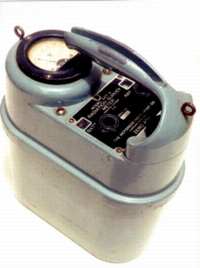Victoreen Model 247A Survey Meter

Victoreen 247 A (ca. 1945-1949)
The Model 247 was designed as a more rugged, waterproof version of Victoreen's first ion chamber survey meter, the "little black suitcase." It was developed and produced in large quantities during World War II as part of the highly secret Operation Peppermint. Operation Peppermint's mission was to counter the potential use of radioactive materials by the Germans against the Allied invasion of Europe . Fortunately, radioactive material was not employed by the Germans and the instruments were not needed.
The thick case of the Model 247A meant that it was only responsive to gamma rays. It (and the Model 247C) employed four ranges: 0-2.5 mR/h, 0 - 25 mR/h, 0 - 250 mR/h, and 0 - 2500 mR/h. The ranges of the Model 247B and 247D were 0- 50 mR/h, 0-500 mR/h, 0-5 R/h and 0- 50 R/h. The difference between the Models 247A and B on one hand and the Models 247C and D on the other was that the latter employed a removable cover over the ion chamber. The removal of the cover greatly improved the response to x-rays.
The Model Series Index produced by the Victoreen Corporation assigns a date of July 1943 to the Model 247 and the Operations Crossroads report by Henry Paul indicates the this instrument used at least as late as 1946 during the atomic tests in the Pacific. The earliest published reference I have for the Model 247A, the version pictured here, is the October 1949 issue of Nucleonics. The radiological control program for the state of Florida , which donated the instrument, claimed that it was one of the first instruments that they purchased and that it dated from 1947. By July of 1950, the Models 247B, C and D were also available.